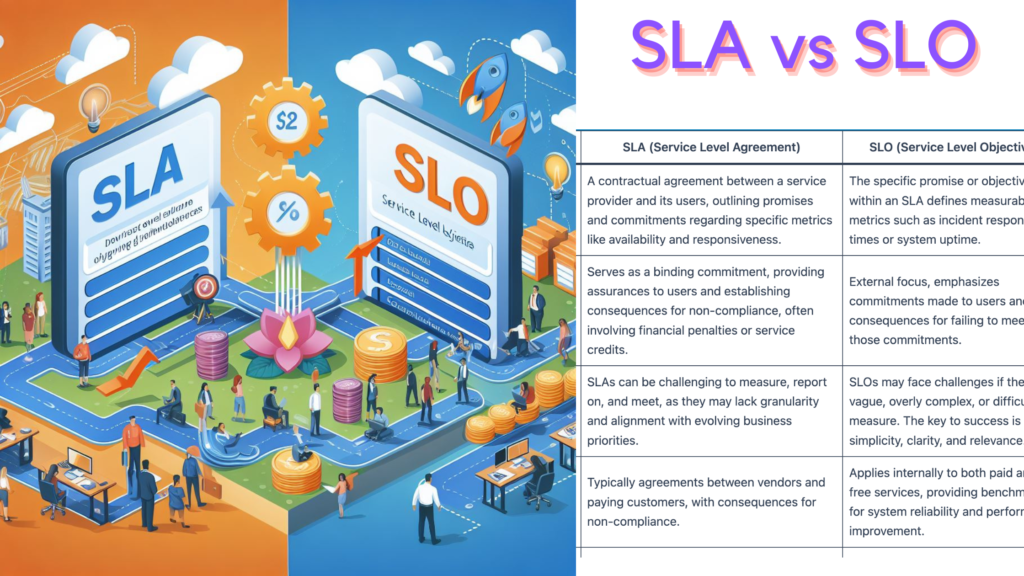In today’s fast-paced, technology-driven world, it’s important for businesses to not only keep up with the competition, but to exceed customer expectations. This is where Service Level Objectives (SLOs) come in – by defining what level of service a business wants to provide to its customers, SLOs set expectations and help measure the success of those efforts.
But how do SLOs actually work in practice? Let’s take a look at a few real-life examples of companies that have implemented SLOs and the impact they’ve had.
Case Study: Google
Google is a prime example of a company that relies heavily on SLOs to ensure the reliability of its services. In fact, the company has a dedicated Site Reliability Engineering (SRE) team that is responsible for setting and meeting SLOs across all Google products.
One specific example of Google’s use of SLOs comes from its cloud platform. When Google introduced its Cloud Key Management Service (KMS), the team responsible for the product set a 99.99% availability SLO. This meant that the service was expected to be available to customers 99.99% of the time.
After implementing the SLO, the KMS team monitored the service closely and made improvements along the way. In the end, they were able to not only meet the 99.99% availability SLO, but exceed it.
Case Study: HubSpot
HubSpot, a marketing and sales software company, is another business that has seen significant impact from implementing SLOs. The company’s SLOs are focused on keeping its platform running smoothly and ensuring customer data is safe and secure.
For example, HubSpot has an SLO that requires platform uptime of at least 99.95%. To meet this SLO, the company has implemented a number of procedures and processes, including frequent monitoring of the platform, regular maintenance updates, and quick response to any issues that arise.
As a result of these efforts, HubSpot has been able to maintain a platform uptime of over 99.99% in recent years.
Certainly! Here are a few more examples of companies that have successfully implemented SLOs:
Case Study: Dropbox
Cloud storage provider Dropbox has also implemented SLOs to ensure the reliability of its services. The company’s SLOs are focused on reducing latency, improving uptime, and increasing throughput for its customers.
To achieve these goals, Dropbox has implemented a number of technical strategies and processes, including load balancing, automated failover, and proactive monitoring. The company has also invested in building a strong SRE team to oversee SLO implementation and monitoring.
As a result of these efforts, Dropbox has been able to improve latency by 40% and reduce downtime by 90%.
Case Study: Etsy
Etsy, a popular online marketplace for handmade goods, has implemented SLOs to ensure the reliability of its website and mobile app for its millions of users.
One specific SLO that Etsy set was to ensure that its website and mobile app load times were under 1.5 seconds. To achieve this target, Etsy implemented a number of technical strategies, including caching frequently accessed data and optimizing database queries.
As a result, Etsy was able to not only achieve its SLO for load times, but improve them by over 50%.
Case Study: Netflix
Streaming video giant Netflix relies heavily on SLOs to ensure that its customers have uninterrupted access to its vast library of movies and TV shows.
One specific SLO that Netflix set was to ensure that its streaming service was available 99.99% of the time. To achieve this target, Netflix developed a number of automated monitoring systems to detect and respond to any issues that arose.
As a result of these efforts, Netflix has been able to maintain an uptime of over 99.99% for its streaming service.
Impact of SLOs
So why do SLOs matter? The impact of SLOs can be seen in a number of ways. Some of the key benefits of implementing SLOs include:
- Improved reliability and uptime of services
- Increased customer satisfaction and loyalty
- Better communication and collaboration between teams
- Increased efficiency and productivity
- Identification of areas for improvement
Conclusion
As these case studies show, implementing SLOs can have a significant impact on the reliability and quality of service that businesses can provide to their customers. By setting clear expectations, investing in technical strategies and processes, and building strong SRE teams to oversee SLO implementation and monitoring, businesses can achieve better outcomes and stay competitive in their industry.
Overall, SLOs are a powerful tool for any business that wants to provide high-quality services to its customers. By setting clear expectations and measuring progress towards those expectations, businesses can achieve better outcomes, increase customer satisfaction, and stay competitive in their industry.

